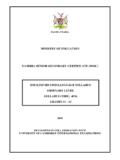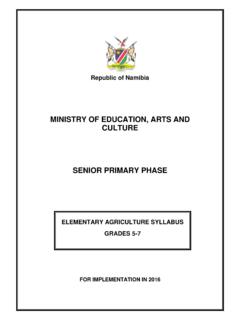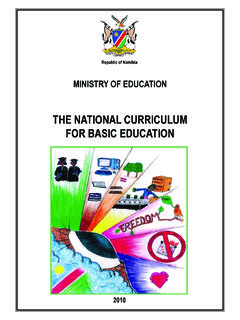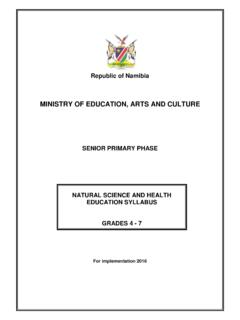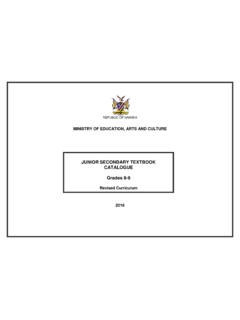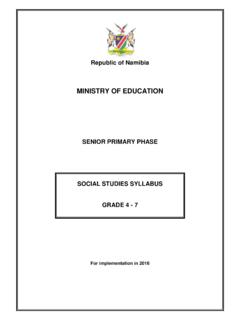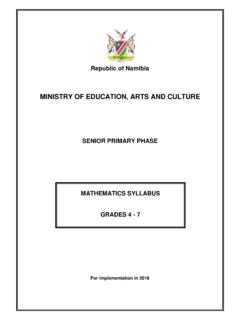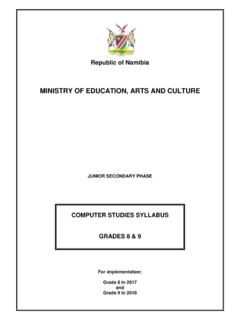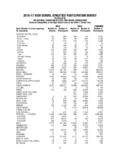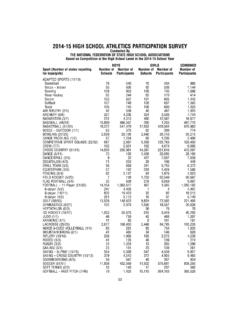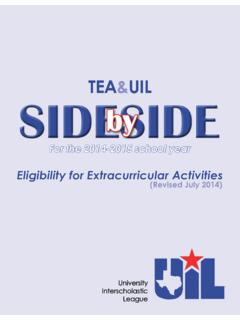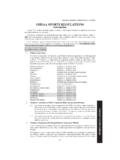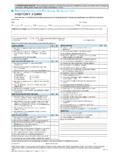Transcription of MINISTRY OF EDUCATION - nied.edu.na
1 Republic of Namibia MINISTRY OF EDUCATION SENIOR PRIMARY PHASE For implementation in 2016 PHYSICAL EDUCATION SYLLABUS GRADES 4 - 7 MINISTRY of EDUCATION National Institute for Educational Development (NIED) Private Bag 2034 Okahandja Namibia Copyright NIED, MINISTRY of EDUCATION 2014 Physical EDUCATION Syllabus Grades 4 - 7 ISBN: 978-99945-2-094-7 Printed by NIED Website: Publication date: 2014 TABLE OF CONTENTS 1. Introduction .. 1 2. Rationale .. 1 3. Aims .. 1 4. Particular features of the subject at this phase .. 2 5. Overall plan of the syllabus .. 2 6. Inclusive EDUCATION .. 2 7. Links to other subjects and cross-curricular issues.
2 3 8. Approach to teaching and learning .. 4 9. End of phase competencies .. 5 10. Summary of the learning content .. 6 11. Learning content .. 8 Learning content for Grade 4 .. 8 Learning content for Grade 5 .. 10 Learning content for Grade 6 .. 13 Learning content for Grade 7 .. 16 12. Assessment .. 20 Types and methods of assessment .. 20 Grade descriptors .. 21 Assessment detailed guidelines .. 21 Assessment rubrics / criteria .. 23 Annexe 1: Assessment record sheet for Grades 4 7 Physical EDUCATION .. 24 Annexe 2: Glossary of Physical EDUCATION Syllabus Grades 4 7, NIED 2014 1 1. Introduction This syllabus describes the intended learning and assessment for Physical EDUCATION in the Senior Primary Phase.
3 As a subject, Physical EDUCATION is within the Physical area of learning, but has thematic links to other subjects across the curriculum as a whole there are three main types of learning experiences in this area. The first type, which is concerned with the development of psychomotor skills, is fundamental for daily life. The second type, which includes play, movement EDUCATION , dance, and sports, is concerned with the development of coordination, social skills, the aesthetic sense and the mastery and enjoyment of movement. The third type, which is concerned with the development of a positive attitude towards one's own body, includes learning experiences that promote an understanding about the development of human sexuality, how the human body functions, and how to stay healthy.
4 Physical EDUCATION consists of fitness, games and sports activities. Under optimal circumstances, this subject would need one period per week and should be supplemented by school sports clubs and sports days. 2. Rationale Physical EDUCATION , as an integral part of the general EDUCATION process, aims to make a meaningful contribution towards improving the quality of life of young people, enabling them to maintain a healthy lifestyle and to function effectively in society. Physical EDUCATION develop attitudes and practices, and further knowledge and activities, which promote physical and mental health; and promote cooperation, positive competition, sportsmanship and fair play through participation in different games and various sports codes.
5 3. Aims The aims of Physical EDUCATION are to: develop and improve the learners perceptual-motor skills through participation in a variety of movement forms (movement development) widen their movement experience and build up a movement vocabulary through participation in a variety of movement forms (movement development) help maintain and develop physical fitness and efficiency (physical development); develop an understanding of good health through an interest in and respect for their own bodies (health development) provide experiences of the joy of movement and develop a positive attitude towards Physical EDUCATION enhance emotional stability including a positive self-image, self-control, independence, confidence, own decision making and creative ability, based on a well-grounded system of values (affective/emotional development) develop healthy interpersonal relationships (social development) develop an understanding of good normative behaviour based on a healthy value system (normative development).
6 Physical EDUCATION Syllabus Grades 4 7, NIED 2014 2 4. Particular Features of the Subject at this Phase Grades 4 - 7 can be characterised as the development phase in Physical EDUCATION . The learners should develop movement through participation in play-like activities in which enjoyable, challenging, self-expressive and self-discovery situations are created. In Grade 4 learners are physically and emotionally energetic and motivated to such an extent that they should start with the development of various techniques, while sports skills will begin to be taught more systematically in Grades 5, 6 and 7. The perspective of Physical EDUCATION is to educate the learner holistically: physically, cognitively, emotionally and socially.
7 The main focus of Physical EDUCATION , therefore, must be to educate the whole person. 5. Overall Plan of the Syllabus The syllabus consists of eight themes, but only four should be covered. Most of the activities can be carried out using simple equipment such as sticks, poles, bean bags, rope, etc., as suggested in the teacher s guide, and schools should be able to offer activities from all the four themes to give breadth and variety to Physical EDUCATION . Time allocation should be adjusted to the situation of a particular school, availability of facilities, interests of the learners, areas of competence of the teacher and availability of other instructors from the community.
8 Physical fitness Gymnastics Athletics Sport skills Water activities Games Dance Health promotion 6. Inclusive EDUCATION Inclusive EDUCATION is the right of every learner and promotes participation in, or access to, the full range of educational programs and services offered by the EDUCATION system in mainstream schools. It is based on the principle of supporting and celebrating the diversity found among ALL learners and removing ALL barriers to learning. Individual Learning Support Plans (ILSP) should be in place to guide and evaluate the individual learning process for learners with special learning needs. Further guidelines on planning for learning and teaching in an inclusive classroom can be found in the Curriculum Framework for Inclusive EDUCATION ( 2014 ).
9 These guidelines will help to equip ALL learners with knowledge, skills and attitudes to help them succeed in the world that is increasingly complex, rapidly changing and rich in information and communication technology. The Junior Primary Phase promotes equal opportunity for males and females, enabling both to participate equally. Teachers should know and understand how to treat learners equally, and all materials should support gender fairness. Teachers must avoid having favourites in the classroom and ensure that their teaching promotes gender equity. Boys and girls will do the same physical activities together, and activities should be organised so that all aspects of physical, cognitive and affective development are taken into account.
10 Physical EDUCATION Syllabus Grades 4 7, NIED 2014 3 7. Links to Other Subjects and Cross-curricular Issues The cross-curricular issues include Environmental Learning; HIV and AIDS; Population EDUCATION ; EDUCATION for Human Rights and Democracy (EHRD), Information and Communication Technology (ICT) and Road Safety. These have been introduced to the formal curriculum to be dealt with in each subject and across all phases, because each of the issues deals with particular risks and challenges in our Namibian society. All of our learners need to: understand the nature of these risks and challenges know how they will impact on our society and on the quality of life of our people now and in the future understand how these risks and challenges can be addressed on a national and global level understand how each learner can play a part in addressing these risks and challenges in their own school and local community The main risks and challenges have been identified as.
